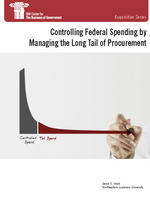
Controlling Federal Spending by Managing the Long Tail of Procurement

In this report, Professor Wyld provides the first quantitative analysis of tail spend in the federal government. In short, tail spend is procurement outlays that are outside of an organization’s core spending and core supplier groups, covering many miscellaneous expenditure categories that are not managed as part of an organization’s core operations.
This report’s publication is timely, as the federal government continues to seek innovative ways to reduce costs in an era of sequestration and tight budgets. Professor Wyld argues that more aggressively managing the tail of government spending — smaller, non-core expenditures that tend to receive less attention — offers the possibility of substantial cost savings. Based on his analysis of government-reported spending in the Federal Procurement Data System (FPDS), Professor Wyld reports that it is possible for the federal government to save between $113 billion and $226 billion by more aggressive management of tail spend. In the Department of Defense, potential savings range from $64 billion to $128 billion.
Professor Wyld sets forth a model that can used in managing tail spend. Specifically, he recommends increased tail spend awareness followed by spend analysis, spend sorting and clarifying, and spend implementation. In addition, the report describes seven specific ways to improve tail spend managing, including identifying maverick, fragmented, and misclassified spending.
Listen to the interview with Professor Wyld on Federal News Radio.
Read the article in Federal Computer Week.
Read the article in fedscoop.



